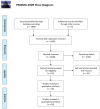Changes of Visual Pathway and Brain Connectivity in Glaucoma: A Systematic Review
- PMID: 29896087
- PMCID: PMC5986964
- DOI: 10.3389/fnins.2018.00363
Changes of Visual Pathway and Brain Connectivity in Glaucoma: A Systematic Review
Abstract
Background: Glaucoma is a leading cause of irreversible blindness worldwide. The increasing interest in the involvement of the cortical visual pathway in glaucomatous patients is due to the implications in recent therapies, such as neuroprotection and neuroregeneration. Objective: In this review, we outline the current understanding of brain structural, functional, and metabolic changes detected with the modern techniques of neuroimaging in glaucomatous subjects. Methods: We screened MEDLINE, EMBASE, CINAHL, CENTRAL, LILACS, Trip Database, and NICE for original contributions published until 31 October 2017. Studies with at least six patients affected by any type of glaucoma were considered. We included studies using the following neuroimaging techniques: functional Magnetic Resonance Imaging (fMRI), resting-state fMRI (rs-fMRI), magnetic resonance spectroscopy (MRS), voxel- based Morphometry (VBM), surface-based Morphometry (SBM), diffusion tensor MRI (DTI). Results: Over a total of 1,901 studies, 56 case series with a total of 2,381 patients were included. Evidence of neurodegenerative process in glaucomatous patients was found both within and beyond the visual system. Structural alterations in visual cortex (mainly reduced cortex thickness and volume) have been demonstrated with SBM and VBM; these changes were not limited to primary visual cortex but also involved association visual areas. Other brain regions, associated with visual function, demonstrated a certain grade of increased or decreased gray matter volume. Functional and metabolic abnormalities resulted within primary visual cortex in all studies with fMRI and MRS. Studies with rs-fMRI found disrupted connectivity between the primary and higher visual cortex and between visual cortex and associative visual areas in the task-free state of glaucomatous patients. Conclusions: This review contributes to the better understanding of brain abnormalities in glaucoma. It may stimulate further speculation about brain plasticity at a later age and therapeutic strategies, such as the prevention of cortical degeneration in patients with glaucoma. Structural, functional, and metabolic neuroimaging methods provided evidence of changes throughout the visual pathway in glaucomatous patients. Other brain areas, not directly involved in the processing of visual information, also showed alterations.
Keywords: glaucoma; neurodegeneration; neuroplasticity; retinal ganglion cells; systematic review.
Similar articles
-
Application of advanced diffusion MRI based tractometry of the visual pathway in glaucoma: a systematic review.Front Neurosci. 2025 May 21;19:1577991. doi: 10.3389/fnins.2025.1577991. eCollection 2025. Front Neurosci. 2025. PMID: 40470296 Free PMC article.
-
Reduced Functional and Anatomic Interhemispheric Homotopic Connectivity in Primary Open-Angle Glaucoma: A Combined Resting State-fMRI and DTI Study.Invest Ophthalmol Vis Sci. 2018 Apr 1;59(5):1861-1868. doi: 10.1167/iovs.17-23291. Invest Ophthalmol Vis Sci. 2018. PMID: 29677346
-
Early changes of brain connectivity in primary open angle glaucoma.Hum Brain Mapp. 2016 Dec;37(12):4581-4596. doi: 10.1002/hbm.23330. Epub 2016 Aug 9. Hum Brain Mapp. 2016. PMID: 27503699 Free PMC article.
-
[Aiming for zero blindness].Nippon Ganka Gakkai Zasshi. 2015 Mar;119(3):168-93; discussion 194. Nippon Ganka Gakkai Zasshi. 2015. PMID: 25854109 Review. Japanese.
-
Diffuse brain damage in normal tension glaucoma.Hum Brain Mapp. 2018 Jan;39(1):532-541. doi: 10.1002/hbm.23862. Epub 2017 Oct 24. Hum Brain Mapp. 2018. PMID: 29064608 Free PMC article.
Cited by
-
Altered Large-Scale Brain Functional Connectivity in Ocular Hypertension.Front Neurosci. 2020 Mar 5;14:146. doi: 10.3389/fnins.2020.00146. eCollection 2020. Front Neurosci. 2020. PMID: 32194370 Free PMC article.
-
Higher Dementia Incidence in Older Adults with Poor Visual Acuity.J Gerontol A Biol Sci Med Sci. 2020 Oct 15;75(11):2162-2168. doi: 10.1093/gerona/glaa036. J Gerontol A Biol Sci Med Sci. 2020. PMID: 32043518 Free PMC article.
-
Cognitive Dysfunctions in Glaucoma: An Overview of Morpho-Functional Mechanisms and the Impact on Higher-Order Visual Function.Front Aging Neurosci. 2021 Oct 6;13:747050. doi: 10.3389/fnagi.2021.747050. eCollection 2021. Front Aging Neurosci. 2021. PMID: 34690746 Free PMC article. Review.
-
Glaucoma - a neurodegenerative disease with cerebral neuroconnectivity elements.Rom J Ophthalmol. 2022 Jul-Sep;66(3):219-224. doi: 10.22336/rjo.2022.43. Rom J Ophthalmol. 2022. PMID: 36349168 Free PMC article. Review.
-
A longitudinal comparison in cynomolgus macaques of the effect of brimonidine on optic nerve neuropathy using diffusion tensor imaging magnetic resonance imaging and spectral domain optical coherence tomography.Heliyon. 2021 Apr 6;7(4):e06701. doi: 10.1016/j.heliyon.2021.e06701. eCollection 2021 Apr. Heliyon. 2021. PMID: 33898826 Free PMC article.
References
LinkOut - more resources
Full Text Sources
Other Literature Sources


